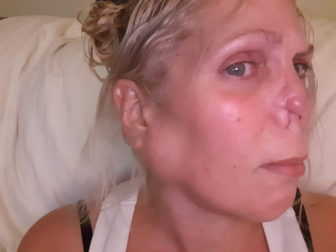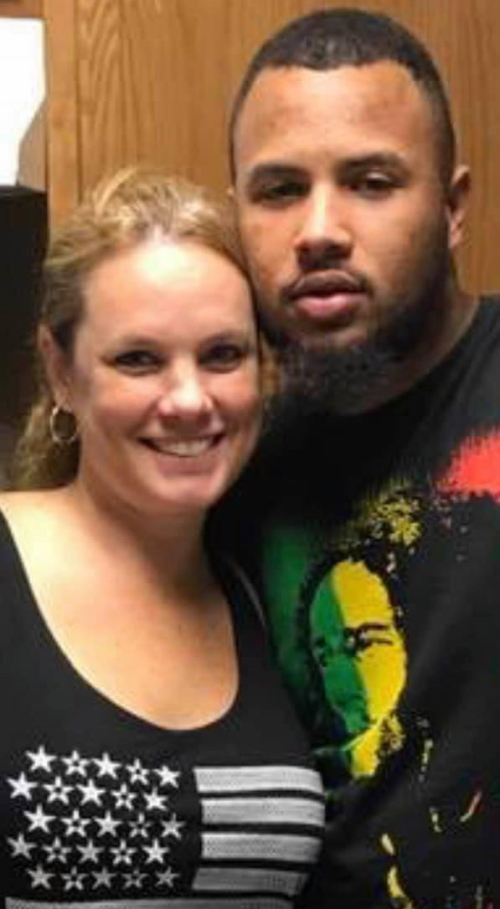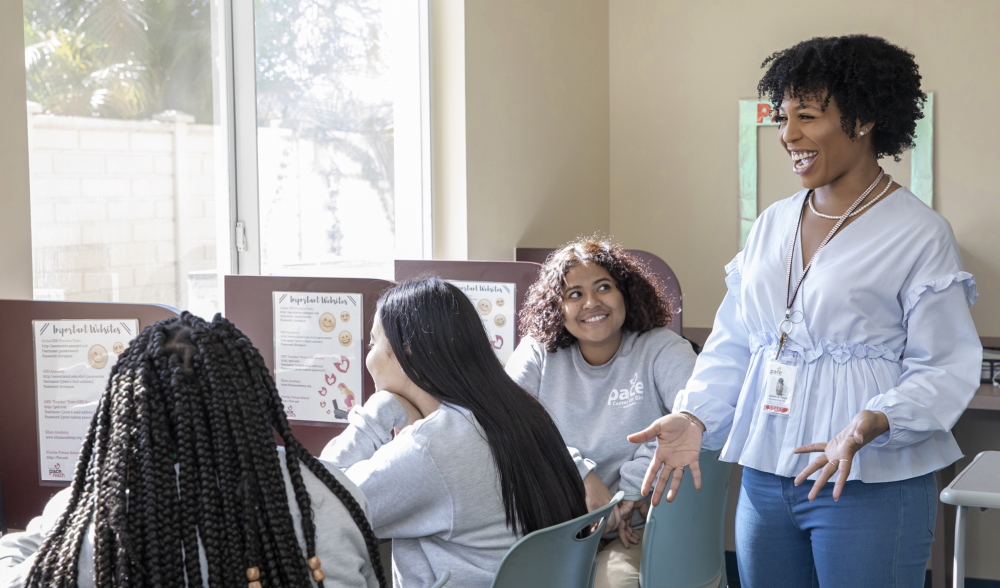JACKSONVILLE, Florida — Rosie Brooks has experienced both of a mother’s worst nightmares involving gun violence.
Her son spent a decade behind bars for an accidental shooting in which a young woman was killed. Then, instead of a joyous reunion when he was released from prison in January 2018, it was a day of mourning. He went from behind bars to standing at his mother’s side at his sister’s funeral. Brooks’ daughter Sahara Barkley had been shot on New Year’s Day at a gas station.
“One gunshot changed my whole world,” Brooks said.
She’s one of thousands of mothers who get the news every year that their child has killed or been killed, most often by guns. Though gun violence has diminished over the last several decades, it remains an epidemic in Jacksonville, where the murder rate is routinely the highest the state; some ZIP codes here outpace nations that are the murder capitals of the world.
Nearly three years after her daughter was killed, Brooks still suffers from insomnia. She gained 100 pounds in the year after her daughter’s death by eating the same meal, Sahara’s favorite, nearly every day.

Courtesy of Rosie Brooks
Sahara Barkley (pictured) was fatally shot on New Year’s Day in 2018. Her mother Rosie Brooks gained 100 pounds the first year after her death, lost her faith and still suffers from insomnia.
“Once my daughter got killed, I quit going to church. I lost all hope. I lost all faith. I lost that zeal to even want to live because that was my baby, that was my baby girl. It took virtue out of me that I can’t even describe,” she said.
Women are often left picking up the pieces following a shooting, shouldering enormous burdens when a loved one is killed, injured or incarcerated. Yet women and girls have remained mostly a footnote in the conversation about preventing gun violence, in part because the vast majority of victims and perpetrators are male.
Today, though, a small but growing number of programs are beginning to target women and girls as part of the long-term strategy to curing the violence problem. The belief is that directing more resources toward women’s economic empowerment, mental and physical health and early intervention can greatly diminish violence and crime. Advocates for reform agree that ending mass incarceration and tightening gun laws would help too, but more and more, violence is viewed as a multigenerational issue with roots in childhood. After all, every murderer has a mother.
“This generation of girls are the next generation of mothers, and if we’re going to break this cycle of poverty and violence, it’s through the girls,” said Mary Marx, CEO of the Jacksonville-based Pace Center for Girls.
When violence starts at home
Wendy Somerset was 8 or 9 years old when she first experienced the threat of gun violence. One night her father inadvertently mixed alcohol with a prescription he wasn’t supposed to, and Wendy awoke to his attacking her mother.
“I saw him take her down on the bed and it looked like he was choking her,” Somerset, 51, said. Her mother managed to get away. “Next thing I know he’s running out the house and he had a gun strapped to his side.”
Her parents divorced, but violence continued to plague her childhood. Her mother remarried, to a man who abused her in front of Somerset and her sister. Her stepfather’s torment extended to the children. “He put the kitten in the microwave,” she recalled. When she was 16, he started sexually harassing her. One night, after he made a remark as Somerset bent to get him a beer, her mother finally decided to take her girls and leave.
“I guess he saw me putting my bags in the back of the car,” Somerset said. “He started chasing me with a gun.”
Experiences such as these reverberate well beyond childhood. Growing up in an abusive household carries long-term physical and mental health risks, according to the U.S. Department of Health and Human Services. It also raises the likelihood of becoming an abuser or experiencing other forms of violence later in life, Everytown for Gun Safety reports.
Somerset remembers, during her trip to Amsterdam in the late ’90s, there was only one murder there that month.
“I get home and we had already had a record number of murders in Jacksonville,” she said.

Courtesy of Wendy Somerset
Wendy Somerset was permanently disfigured in 2006 by a vicious pistol whipping during a mugging. Her facial injuries have made it impossible for her to find work. She is scheduled for her 18th round of surgeries.
In 2006, Somerset was permanently disfigured by a vicious pistol whipping during a mugging. She says her facial injuries have made it impossible for her to find work. Today she’s on disability and holding out hope that her 18th round of surgeries will make her whole again. She’s grateful to be alive, but trauma haunts her.
“I haven’t had a whole lot of help. I was in a severe depression for quite a while,” she said.
The lack of access to mental health resources for survivors of violence is particularly problematic in Florida, which ranks 44th in the nation for mental health. And some parts of Jacksonville with the highest rates of violent crime are essentially mental health deserts.
Tracye Polson, a local therapist and clinical social worker who specializes in trauma, said people have to travel 10 miles outside of ZIP codes with the highest rates of violence for mental health care, which can be hard for minors and families without reliable transportation.
“If you are a young girl or a young woman and you’ve been subjected to gun violence and you’re in the Durkeeville area, there are very few resources for you,” she said. Durkeeville’s ZIP code, 32209, routinely has among the highest rates of gun violence in the city.
While the United Way serves as a conduit to finding mental health care, you have to know where to look, and many don’t, or they don’t have reliable internet access, Polson said. She believes it would be particularly beneficial if people from the area were trained to provide mental health care.
“We know where the higher incidents of gun violence is … we could do it strategically,” she said.
Without mental health care, girls who experience trauma are much less likely to break the cycle when they grow up and become mothers themselves.
Advocates say it’s also vital to economically empower women to end intergenerational poverty and violence, which often begins at home. Studies have shown that poor women are far more likely to experience domestic violence, but many mothers in abusive or unhealthy relationships remain because they simply can’t afford to leave.
“We have found that [economics are] one of the number one reasons that survivors stay in abusive relationships or go back to abusive relationships,” said Gail Patin, CEO of Hubbard House, which provides shelter and resources for people experiencing domestic violence.
An epidemic with roots in childhood
Advocates say that ending intergenerational poverty needs to include efforts aimed at children, such as local organizations that help girls become financially independent in adulthood, including the Girls Scouts, Girls Inc. and Pace Center for Girls.
The Kids Hope Alliance (KHA), the city of Jacksonville’s hub for resources to help children who may otherwise slip through the cracks, served 33,500 children last year through its network of providers, according to its annual report. It links women and families with nutritional assistance, mental health care and more.
That’s in line with the national trend away from trying to arrest ourselves out of violent crime. As understanding of the underlying causes of violence evolves, the U.S. has slowly moved toward a more nuanced approach designed to prevent rather than simply punish. And prevention starts much earlier than the days or weeks leading up to a violent act; research shows that one of the greatest contributors to violence, both for perpetrators and victims, are adverse childhood experiences (ACEs).
ACEs include abuse and neglect, exposure to domestic violence, substance abuse and mental illness. The more ACEs a person has, the greater their likelihood of negative outcomes and experiences over their lifetime. The Centers for Disease Control and Prevention (CDC) has found that girls more frequently experience these traumas than boys do, and they are more likely to experience multiple traumas. Four or more ACEs greatly increase the likelihood that someone will experience or perpetuate violence.
Being traumatized or troubled in childhood doesn’t guarantee future violence, negative health outcomes, poverty or criminality, however.
Every year, the Pace Center for Girls works with 3,000 girls from around Florida with issues like failing classes, dropping out of school, behaviors associated with delinquency and involvement in the juvenile justice system. Marx, who runs the Pace Center, describes these behaviors as symptoms of their experiences with violence and trauma. A third of the middle- and high school-aged girls it serves have domestic violence in their backgrounds; 20% have experienced physical or sexual abuse. Half have mental health issues. More than half have a parent who’s been incarcerated. A large majority live in poverty.
Pace teaches girls a way of coping, with gender-specific counseling and education that is more relational than programs designed for boys.
“Once you’ve done that, then the girls can be very successful in their own path, not only graduating high school but going into the world of work,” Marx said.
By teaching girls to recognize and process their trauma and unlearn self-defeating behaviors, Pace has achieved high levels of success. According to its most recent report, two-thirds of girls at the start of the program have been expelled; a year after completing it, nearly 90% are either in school, employed or pursuing higher education. It’s similarly successful keeping girls out of the juvenile justice system and helping them improve their grades.
Keeping kids out of the jail makes them less likely to be incarcerated later in life. As is true with poverty, incarceration and single motherhood, girls of color are disproportionately represented in the juvenile justice system. Marx said that half the girls Pace works with in Jacksonville, where a third of the population is Black, are Black.
Still, over the last decade, Florida has significantly reduced the number of girls it locks up. Marx said the state was arresting 20,000 girls annually in 2010: “It was called the sexual abuse-to-prison pipeline.” A decade later, she said, the state has reduced arrests of girls by 136%.
But there’s still plenty of work to be done to end intergenerational poverty and incarceration. Marx believes that schools could model some of Pace’s techniques for all children and should consider broadening their role beyond purely educational. Teachers are asked to do too much, she said, but schools could more effectively reach children who are struggling academically or behaviorally by improving access to counseling and other services associated with social work.
“Schools need to rethink themselves as places of safety, because in order to be able to heal, girls need and all kids need places that are physically and emotionally safe for them,” she said.
Going it alone
Leon D’Shawn Bennett’s future was looking bright when he was killed after a fight in Jacksonville Beach on June 14, 2018. Bennett, an up-and-coming rapper known as Lee Kahn, had just completed a tour of the Southeast, and a studio in Atlanta was interested in his music. He was one of four people killed in separate shootings that weekend in Duval County.

Rhonda Phillips, who raised four children herself, was especially close to her son Leon D’Shawn Bennett. He was killed in 2018 after a fight. She worked retail, often getting home late at night, which meant her children went without adult supervision.
Bennett’s mother Rhonda Phillips describes her son as a family man, devoted to his two young sons and a frequent babysitter of his niece. She and her son were particularly close, a bond that had grown even stronger when she left his father, who was taking “the wrong path in life.”
Raising four kids on her own came with challenges familiar to the 16 million single parents in the U.S., 81% of whom are women, according to Pew Research Center. “One person has to play both parts, but you also have to hold a full-time job,” Phillips said.
She worked retail, often getting home late at night, which meant her children went without adult supervision. When they were young, she could bus them to the Police Athletic League, she said, but when they entered their teen years, a time when children typically need more, not less, parental involvement, there was a dearth of options.
“I wish there were more places that children could go to after school,” Phillips said. “… If there were more of that around, it would help so many children.”
Mothers scraping by on low wages often face difficult choices about raising their children. Pew reports that nearly 30% of all single mothers live in poverty. In Jacksonville, it may be even higher. According to the Census, nearly 1-in-6 local residents live in poverty, significantly higher than the national rate of roughly 1-in-10. Based on national trends, a disproportionate share of the city’s roughly 145,000 impoverished residents are likely women and children.
Patin of the Hubbard House women’s shelter believes that lifting single mothers out of poverty could help diminish violent crime overall. Florida’s recent state constitutional amendment raising the minimum wage to $15 per hour by 2026 may have this arguably unintended effect.
While correlation is not causation, growing up in a single-parent household significantly increases the likelihood of being incarcerated, in part because single mothers are one of the most impoverished groups in America.
And then there’s the toll on those mothers. Brooks said that her son’s incarceration had domino emotional, spiritual, financial and physical effects.
“To this day I struggle with congestive heart failure,” she said.
A nationwide study by the Essie Justice Group found that “at least 1-in-4 women has an incarcerated loved one.” Of the thousands of women with a current or formerly incarcerated loved one, more than half have children or child care responsibilities.
The study also found that women shoulder much of the financial impact of incarceration. More than a third have experienced homelessness or housing insecurity as a result of a loved one’s incarceration.
A 2015 report, "Who Pays: The True Cost of Incarceration on Families," found that more than 80% of those paying court costs for incarcerated loved ones were women; more than 65% of those who did so struggled to pay rent, buy food and other essentials.
The financial hardship doesn’t end with sentencing, however. Prisons charge exorbitant sums for items such as soap, snacks, even medical care. Brooks estimated that over the decade her son was in prison, the family spent tens of thousands of dollars on phone calls and ensuring he wasn’t “jail poor.”
Women have the answers
Women who experience violence or lose loved ones to it have ideas for solutions. Each of the women interviewed for this article strongly agreed that stricter gun laws are one of the pieces to the puzzle. All also brought up the need for access to health care. Aftercare programs for kids, required gun safety education and grief counseling might also help.
Bennett’s killer was never charged with his death. Following a fight with two men, he walked to his car. They started taunting him. Then shots rang out.
“They still got away with the Stand Your Ground law because my son touched their car,” Phillips said. She wants the law to be repealed. “It almost allows anybody to use the excuse, ‘I feared for my life.’”
Brooks, a bail bondswoman and a licensed concealed weapons carrier, thinks children should learn about both the safe use and dangers of firearms from people like her who have experienced the tragedy of gun violence firsthand.
She plans to launch a nonprofit in her daughter’s name that will provide counseling for children affected by gun violence.
Somerset shares her experiences online and dreams of one day speaking to college students.
“I’m grateful to have my story and I’m grateful to be able to share it with people who gave up,” she said.
Phillips is a survivor leader with Moms Demand Action. “When families are impacted by gun violence, I try to reach out … to offer advice, tell them about the things I know that are out there,” she said.
And Marx urges a public health approach and addressing violence and poverty as intergenerational issues. Pace is piloting a program in Broward County that works with the entire family. “It [violence] needs to be attacked on a couple of levels. One is awareness, and awareness of reframing violence as a public health crisis — because it is.”
This is the fourth in a Northeast Florida-focused series collaboration between WJCT and the Center for Sustainable Journalism, which publishes Youth Today and the Juvenile Justice Information Exchange. This series is part of the Center’s national project on gun violence. Support is provided by The Kendeda Fund. The Center is solely responsible for the content and maintains editorial independence.
